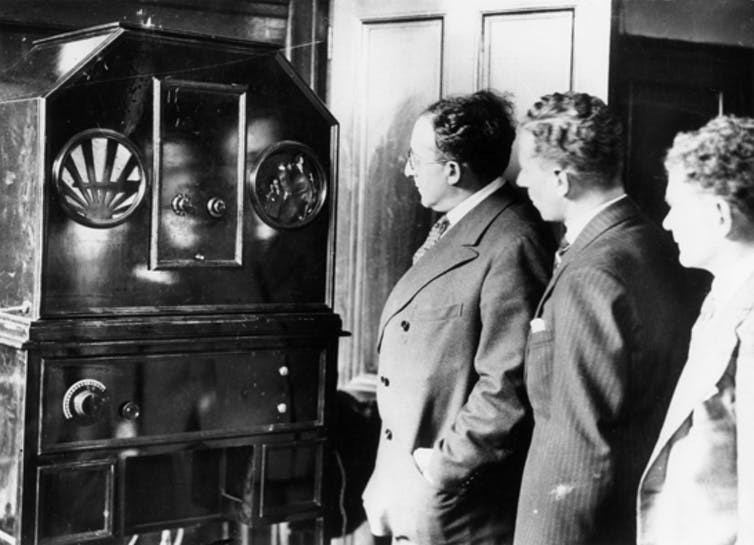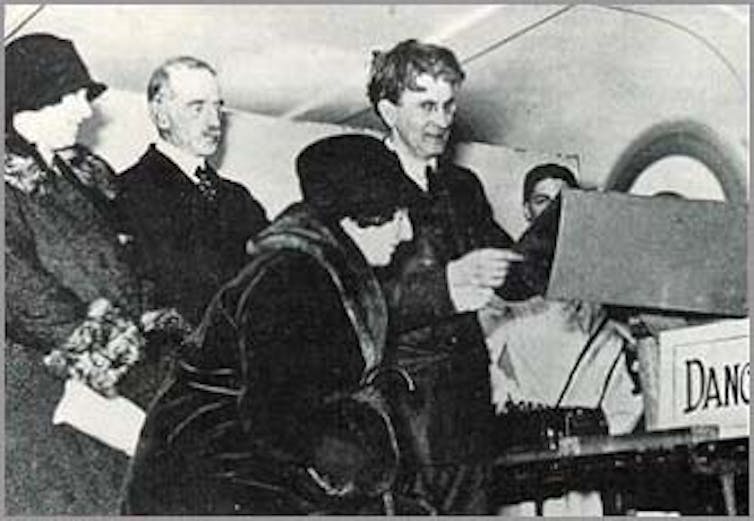How public TV broadcasting was born

The first BBC television transmissions, September 1929. Science Museum
30 September 2019
Writing in The Conversation, Dr Jamie Medhurst (Reader in Television and Media History) discusses the first public television broadcast which took place on 30 September 1929, and how the world would never be the same again:
It was 90 years ago that a handful of amateur wireless enthusiasts, most of them living in London, were treated to their very first experience of television. Watching on mainly home-built sets, they viewed and listened to speeches by the scientist Sir Ambrose Fleming, a “turn” by comedian Sydney Howard, a song from Miss Lulu Stanley and a speech from television pioneer John Logie Baird. It was the first actual broadcast of television to a public watching in their own homes. The world would never be the same again.
Television, that most ubiquitous of all media, has a long and distinguished history. The pioneering work of scientists and inventors, including Paul Nipkow in Germany, Charles F. Jenkins in the United States, Denes Von Mihaly in Hungary, and Baird in the UK, ensured that in time, television would be in every home allowing the viewing audience to be informed, educated and entertained.
In the UK, it is often thought that television “proper” began with the launching of the BBC Television Service on November 2 1936 from the studios at Alexandra Palace in North London.
But this was not the first television service. On September 30 1929 an experimental television service from the Baird Television Company began broadcasting using the BBC’s London transmitter (2LO). The Radio Times entry for 11.00-11.30 on the day shows an “Experimental Television Transmission by the Baird Process” nestled between a wireless talk on “How I Planned my Kitchen” and a wireless programme of gramophone records.
This somewhat insignificant billing belies a momentous event – a culmination of years of experimentation, press interest, and political lobbying by some of British television history’s key players.
Watching ‘by wireless’
The first steps to “see by wireless” or “see by electricty” were being taken in Britain in 1923 by a Scot, John Logie Baird. He was one among a number of scientists, inventors and enthusiasts across the world who were, at that time, trying to build on the success of the telephone, the telegraph, the cinema and, of course, radio – the British Broadcasting Company (BBC) was created and started broadcasting in November 1922 under the watchful eye of John Reith, the first managing director (later director-general).
In these very early years, there was no concept of a television “service” or, indeed, what TV actually was or might become. It was the idea of seeing things – in real time – at a distance which drove these pioneers. In April 1925, Baird demonstrated his new idea at Selfridges in Oxford Street, London. Hundreds of people came to wonder at this latest miracle, although the images being produced by the apparatus were barely recognisable.

After further experimentation, Baird demonstrated his 30-line (low definition) mechanical television equipment to members of the Royal Institute at his laboratories in Soho, London on January 26 1926 – the first demonstration of “true” television in the world.
Despite the positive responses, television was still laboratory-based and was not at the stage of being considered ready for public use. But Baird’s close associates were keen to publicise this new miracle of science and the press increasingly ran stories relating to seeing events at a distance.
At the same time in the United States, experiments in television were producing positive results. Images were transmitted over a great distance by the American Telephone and Telegraph company – an event which prompted one British MP, Sir Harry Brittain, to refer to television as something which might become “a very tiresome invention”.
BBC and Baird
Around this time also the BBC was becoming aware of the public and press interest in television. But its initial response to the new invention was lukewarm to say the least (hostile might be closer to the mark). The British Broadcasting Corporation (formerly the British Broadcasting Company before the change of status in January 1927) had good reason to be sceptical.
Based on demonstrations given to engineers from the BBC and the General Post Office (the government department responsible for broadcasting at the time) in 1927 and 1928, the quality of the image being produced was considered to be too low for the general viewer. It’s also worth remembering that the BBC had only been operating a radio service since 1922 and this was its priority in terms of reaching and audience and in terms of finance.
But the Baird Television Company needed to get its experimental programmes out from the laboratory if it was to sell television sets, and the only way of doing this was to cooperate with the BBC who had the requisite technical infrastructure in terms of transmitters and wavelengths.
Eventually, following pressure on the Postmaster-General from the Baird Company, who in turn put pressure on the BBC, the Corporation reluctantly allowed Baird to transmit his experimental programmes via the BBC’s 2LO transmitter in London, and the first of these went out on September 30 1929 to the handful of enthusiasts who had built their own sets and hooked them up to their wireless sets.
Due to the scarcity of wavelengths, the picture was transmitted first, followed by the sound. So viewers would watch a silent picture on one wavelength and would then have to retune to another wavelength to listen to the sound which accompanied the vision.
Synchronised sound programmes were finally transmitted from March 1930 onwards and included the first television drama to be produced in the UK in July 1930, Luigi Pirandello’s The Man With a Flower in His Mouth. The television revolution had begun and the “tiresome invention” would go on to conquer the world.![]()
Jamie Medhurst, Reader in Television and Media History, Aberystwyth University
This article is republished from The Conversation under a Creative Commons license. Read the original article.



